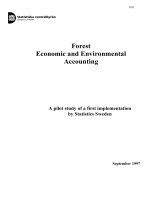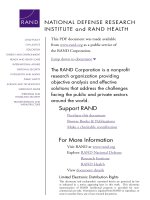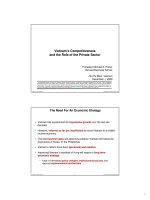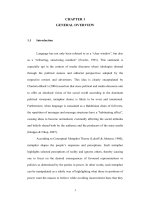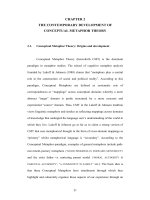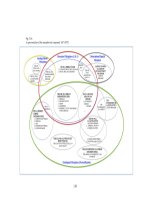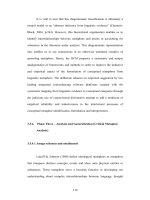Performance appraisal fairness, work engagement, and intent to leave, the study of employees in the private sector
Bạn đang xem bản rút gọn của tài liệu. Xem và tải ngay bản đầy đủ của tài liệu tại đây (773.82 KB, 90 trang )
UNIVERSITY OF ECONOMICS HO CHI MINH CITY
International School of Business
------------------------------
Do Thi Tuyet Nhung
PERFORMANCE APPRAISAL
FAIRNESS, WORK
ENGAGEMENT, AND INTENT
TO LEAVE: THE STUDY OF
EMPLOYEES
IN THE PRIVATE SECTOR
MASTER OF BUSINESS (Honours)
Ho Chi Minh City - Year 2014
UNIVERSITY OF ECONOMICS HO CHI MINH CITY
International School of Business
------------------------------
DO THI TUYET NHUNG
PERFORMANCE APPRAISAL
FAIRNESS, WORK
ENGAGEMENT, AND INTENT
TO LEAVE: THE STUDY OF
EMPLOYEES
IN THE PRIVATE SECTOR
ID: 21110013
MASTER OF BUSINESS (Honours)
SUPERVISOR: Nguyen Huu Lam, Dr.
Ho Chi Minh City – Year 2014
ACKNOWLEDGE
I would like to express my gratitude to supervisor Dr. Nguyen Huu Lam for his
guidance, support, motivation, and understanding in all the time of my research. Besides
my supervisor, I would like to thank ISB committee for their encouragement, and
insightful comments.
I would like to thank managers in HR Share and Care group and my classmates
at ISB.MBus 2.3 for their sharing honestly in item generation and other phases. They
have provided important comments for my questionnaire as well as data analysis
methods. Especially, I am debted to my classmate Thai Van Trung Hieu for his
supporting and sharing about SEM analysis. In addition, I would like to thank
participants in my investigation without charge.
In my daily work, I have been blessed with my chiefs and staffs at the Joton JSC
for all their supports. Especially, I am obliged to my direct chief Mr. Hoang Minh Anh
for his support and my subordinate Ms Nguyen Thi Hoang Anh for her assistant at work
for me to finish thesis conveniently.
Finally, I would like to give my special thanks to my family whose love helped
me to complete this work.
i
ABSTRACT
While Vietnam builds the Socio-Economic Development Strategy 2011-2020
with paying attention to human resource management and development, many
organizations concern performance management and talent management in which
performance appraisal, work engagement, and intent to leave are important concepts.
The study is conducted to identify whether perceived performance appraisal fairness can
help employees to enhance their engagement at work as well as whether engaged
employees can reduce their intent to leave organizations. A sample of 170 employees
from 15 organizations in the private sector was used to test hypotheses relating to these
three concepts. The results indicated that perceived performance appraisal fairness
affected positively on work engagement and work engagement influenced negatively to
intent to leave in Vietnam context. Generally, the present study suggests important
guidelines for private organizations to ensure fairness of performance appraisal system;
thereby, it can help to enhance work engagement and manage employee turnover by
controlling intent to leave.
Key words: performance appraisal fairness, work engagement, intent to leave
ii
TABLE OF CONTENTS
AKNOWLEDGE................................................................................................................................ i
ABSTRACT....................................................................................................................................... ii
TABLE OF CONTENTS................................................................................................................ iii
LIST OF TABLES............................................................................................................................. v
LIST OF FIRGURES....................................................................................................................... vi
LIST OF ABBREVIATIONS....................................................................................................... vii
Chapter 1: INTRODUCTION......................................................................................................... 1
1.1. Research Background........................................................................................................... 1
1.2. Research Problem.................................................................................................................. 3
1.3. Research Objectives.............................................................................................................. 6
1.4. Scope and Contribution of the Study................................................................................ 6
1.5. Thesis Structure...................................................................................................................... 7
Chapter 2: LITERATURE REVIEW............................................................................................ 8
2.1. Perception of Performance Appraisal Fairness............................................................... 8
2.1.1. Performance Appraisal Overall.................................................................................. 8
2.1.2. Fairness of Performance Appraisal System........................................................... 11
2.2. Work Engagement............................................................................................................... 14
2.3. Intent to Leave..................................................................................................................... 16
2.4. Perceived Performance Appraisal Fairness and Work Engagement........................ 18
2.5. Work Engagement and Intent to Leave.......................................................................... 20
2.6. The conceptual model and hypotheses of the research............................................... 20
Chapter 3: RESEARCH METHODOLOGY............................................................................ 22
3.1. Research design................................................................................................................... 22
3.1.1. Research Method.......................................................................................................... 22
3.1.2. Research Process......................................................................................................... 23
3.1.3. Population and Sampling Method............................................................................ 24
3.1.4. Measurement Instruments.......................................................................................... 25
3.1.5.Coding.............................................................................................................................. 27
3.1.6. Sample Size.................................................................................................................... 27
iii
3.1.7. Data Collection............................................................................................................ 28
3.1.8. Data Analysis Method................................................................................................. 28
3.2. Item Generation................................................................................................................... 33
3.3. Pilot Study............................................................................................................................. 34
3.4. Main Study............................................................................................................................ 36
Chapter 4: RESULTS AND DISCUSSIONS............................................................................ 38
4.1. Participants’ Demographic................................................................................................ 38
4.2. Assessment of Scales.......................................................................................................... 39
4.2.1. Assessment of Scale by Cronbach’s Alpha Cofficient.......................................... 40
4.2.2. Assessment of Scale by Exploratory Factor Analysis.......................................... 41
4.2.3. Assessment of Scale by Confirmatory Factor Analysis....................................... 42
4.3. Saturated Measurement Model........................................................................................ 45
4.4. Structural Model.................................................................................................................. 48
4.4.1. Maximum Likelihood Method................................................................................... 48
4.4.2. Bootstrap Method......................................................................................................... 50
4.5. Testing the Hypotheses...................................................................................................... 51
4.6. Discussions for Findings................................................................................................... 52
Chapter 5: FINDINGS AND IMPLICATIONS....................................................................... 55
5.1. Conclusions.......................................................................................................................... 55
5.2. Management Implications................................................................................................. 56
5.3. Limitations and Directions for Further Researches..................................................... 57
REFERENCES
APPENDICES
iv
LIST OF TABLES
Table 4.1: Characteristics of the participants............................................................................ 38
Table 4.2: Correlation between constructs of perceived performance appraisal fairness 44
Table 4.3: Correlation between research concepts................................................................... 46
Table 4.4: Results of reliability and average variance extracted.......................................... 47
Table 4.5: Result of regression weights...................................................................................... 49
Table 4.6: Regression weights by maximum likelihood and bootstrap.............................. 50
Table 4.7: Results of testing hypotheses.................................................................................... 52
v
LIST OF FIGURES
Figure 2.1: Performance appraisal process................................................................................ 10
Figure 2.2: Greenberg's Taxonomy of Justice Perceptions Applied to Performance
Appraisal..................................................................................................................... 13
Figure 2.3: The conceptual model............................................................................................... 21
Figure 3.1: Research process........................................................................................................ 23
Figure 4.1: CFA for perceived performance appraisal fairness scale.................................. 43
Figure 4.2: CFA for work engagement and intent to leave scale.......................................... 45
Figure 4.3: CFA for saturated measurement model................................................................. 47
Figure 4.4: Result of structural equation modeling................................................................. 49
vi
LIST OF ABBREVIATIONS
AMOS
: Analysis of Moment Structures
AVE
: Average variance extracted value
CFA
: Confirmatory Factor Analysis
CR
: Critical ratio value
EFA
: Exploratory Factor Analysis
HRM
: Human resource management
KMO
: Kaiser-Meyer-Olkin measure of sampling adequacy
ML
: Maximum Likelihood exploratory program
PAF
: Principal Axis Factoring
PCA
: Principal Component Analysis
SEDS
: The Socio-Economic Development Strategy
SEM
: Structural Equation Modeling
SPSS
: Statistical Packed of Social Sciences
UWES
: Utrecht Work Engagement Scale
vii
Chapter 1
INTRODUCTION
1.1.
Research Background
The fact that Viet Nam has been a member of the World Trade Organization
since January 11, 2007 is a successful step in the efforts to integrate into the global
marketplace. The current economic development is believed to be attributable to the
political and economic reforms (Doi Moi), which was launched in 1986 (Nghiep & Quy,
2000). The new policies have prompted Vietnamese economy from a closed system into
a multi-sector, globally integrated market economy with socialist characteristics. The
World Bank reports that Vietnam has developed from one of the poorest countries in the
world, with per capita income below 100 dollars, to a lower middle-income country
within a quarter of a century with per capita income of 1,130 dollars by the end of 2010
(Vietnam overview, n.d). One of the most remarkable achievements of Vietnam’s
economic transition is the emergence of more dynamic and stronger private sector
(Hakkala & Kokko, 2007). Asian Development Bank defines the private sector as all
individuals or groups of individuals who invest or use private capital to produce or trade
goods or services. Therefore, in Vietnam, this definition includes formal and informal
enterprises and collectives, domestic and foreign (ADB, 2005). Bartram, Stanton, and
Thomas (2009) states that the Vietnamese government encourages a multi-sector
economy and actively promotes the growth of private enterprises as crucial factors
shaping the development of the economy.
1
As some other emerging economies seeking to compete in globalised markets,
Vietnam is facing many challenges (Truong, Van der Heijden, & Rowley, 2010).
Vietnam’s ability to succeed with low cost strategy is under threat and needs to change
due involving a downward spiral around low cost competition is dangerous and harmful
for long term and with impacts on key human resource management (HRM) policies
and practices (Truong et al., 2010). Vietnam government builds the Socio-Economic
Development Strategy (SEDS) 2011-2020 with paying attention to structural reforms,
environmental sustainability, social equity, and emerging issues of macroeconomic
stability. Three main issues in SEDS include: (i) promoting human resources/skills
development (particularly skills for modern industry and innovation),
(ii) improving market institutions, and (iii) infrastructure development (Vietnam
Overview, n.d). In the SEDS, the human resource development is placed first indicates
that Vietnamese government has concern on the importance of this resource in the
integration process. Obviously, when entering the international arena, the competition
among companies has become unprecedented level by the pressure of globalization,
which is known as the increasingly close international integration of markets for goods,
services and factors of production, labor and capital (Bordo, 2002). More globalization
means more competition “to lower costs, to make employees more productive, and to do
things better and less expensively” (Dessler, 2011, p. 6). Therefore, to face the pressure
of competition, an effective human resources management has been seen as a critical
factor in creating competitive advantage (Pfeffer, 1999).
2
Under the growing pressure of globalization and integration, HRM in Vietnam is
becoming pragmatic in practices, particularly in relation to the widespread use of
training and development as well as the use of performance appraisal and incentive
payments (Bartram et al., 2009). Private companies in Vietnam are making efforts to
formalize their human resource policies to meet foreign requirements, remain
competition, attract good candidates, and keep talent employees (Bartram et al, 2009).
While many Vietnamese companies apply difficultly foreign HRM theories and
practices to enhance competitiveness, foreign invested companies face the fundamental
question of the transferability of HRM practices into local settings (Thang, Rowley,
Quang & Warner, 2007).
1.2.
Research Problem
In an era of expanding globalization and increasing competition, organizations
worldwide have recognized that the knowledge, skills, and abilities of their employees
represent a major source of competitive advantage (Lewis & Heckman, 2006). Since the
private sector grows and competes openly for experienced and skilled staff, HRM is
assumed as an important function to manage talents (Bartram et al, 2009). In Vietnam,
although many managers in domestic private companies are extremely interested in
experimenting with innovations in HRM (Bartram et al., 2009), the majority of these
applications are still in the first phase of development and generally lack a strategic
HRM focus and positioning (Truong et al., 2010). Whereas, foreign invested companies
need to concern the adoptability of some Western HRM practices into the Vietnamese
context because the import of foreign HRM practices demands a careful consideration
of their compatibility with Vietnamese contexts and cultural
3
values (Thang et al., 2007). In addition, Thang et al. (2007) suggest that the foreign
practices that tend to offer compromise with the norms, beliefs, and assumptions of the
existing Vietnamese culture have the best chance to be transferred to improving the
rigid system in managing and motivating people. Von Glinow and Clarke (as cited in
Thang et al., 2007) also indicate that the attempts to seek confrontation or to impose
ethnocentric practices of HRM will fail, as an early warning for the prospective
American companies aiming to Vietnam. Thang et al. (2007) implicate that performance
management need to take a long-term view and gradually cultivate among its people a
trusting, open and frank environment, as well as provide sufficient training to bring
these knowledge into practice.
When organizations talk about the performance management, they frequently
mention the practice of formal performance appraisal as a primary vehicle for
management change (Longenecker, 1997). Performance appraisal is one of the most
important HRM practices in organizations as it yields critical decisions integral to
various human resource actions and outcomes (Gupta & Kumar, 2013). However,
performance appraisal systems in private companies face many disadvantages in
Vietnam. Long (2007) considers that some Vietnamese companies have allowed
superior to assess performance and attitude of subordinate at the end of the year while
others have used voting method relying on the results of emulation, commendation, and
punishment for ranking employees in each department, and then proposed to the board
of directors for approval. By any manner, performance appraisal in Vietnamese
companies often create controversy, discontent and disunity in the organizations
because the assessment methods are not scientific, not transparent, unfair and results
4
of assessment had often based on comments by emotions, bias of the supervisor (Long,
2007). Tan (2011) presents that probably more than 80 percent of staff asked about
performance management system will think that this system is unfair, meaningless, and
a waste of time; whereas, many human resource managers are aware of this issue but
ignore and still proceed with their system knowing the actual consequences and results.
Therefore, Tan (2011) warns that the organizations need to look more closely at their
performance management and appraisal systems because there are many factors, such as
obsolete system, wrong design, or poor rating, are not only useless but can actually
harm productivity and the relationships between employees and managers.
In addition, as conditions have become more competitive, companies face
pressure in recruiting skilled and talented people at the top of the labour market (Truong
et al, 2010). Ruge (2011) shows that employee intent to continue working for current
companies is lower in Vietnam (54%) compared to Asia Pacific (61%). Loose (2011)
suggests that the engagement and retention strategies in Vietnam should focus on a total
reward strategy basing on employee performance beyond just compensation only
historically to attract and retain talents.
Generally, under the pressure of limitation of resources and competition, private
companies need to improve talent management. To deal with turnover, managers should
build human resource strategies how to manage and control turnover as well as to retain
talent. Some previous researches evoke relationship of work engagement with
performance appraisal justice and with intent to leave (Schaufeli & Bakker, 2004; Saks,
2006; Cropanzano, Bowen, & Gilliland, 2007; Alam &
5
Mohammad, 2009; Gruman & Saks, 2011) in many countries that include transition
economies such as India, Malaysia. While perception of performance appraisal fairness
is believed to significantly influence on work engagement (Gupta & Kumar, 2013),
work engagement is received attention from researchers as an important determinant of
employee performance recently (Gruman & Saks, 2011). Therefore, a study was
conducted to examine the relationship between perceived performance appraisal
fairness, work engagement, and intent to leave in Vietnam context under the pressure of
globalization and integration.
1.3.
Research Objectives
The study is undertaken with the following objectives:
1. To identify relationship between perceived performance appraisal fairness
and work engagement
2. To examine relationship between work engagement and intent to leave
1.4.
Scope and Contribution of the Study
The study focused on employees working for local and foreign private
companies in Ho Chi Minh City. The respondents were white-collar officials including
staff and manager, and they have experienced in performance appraisal.
This study provides evidences about the relationship between perceived
performance appraisal fairness, work engagement, and intent to leave in Vietnam
context. Findings from this study can be useful for managerial people to conduct
programs and policies for preparing and maintaining HRM in private organizations. The
clearer understanding of three concepts may help to create stable and engaged work
environment, reduce recruitment cost, and develop competitive advantages.
6
1.5.
Research Structure
This thesis includes five chapters. Chapter 1 introduces research background and
research problems providing general views about Vietnam market. It also states research
objectives and questions, scope and contribution of thesis, thesis structure. Chapter 2
provides literature review relating to performance appraisal fairness, work engagement,
and intent to leave. From literature, a research model and two hypotheses are proposed.
Chapter 3 gives the research methodology applied to conduct this study. It includes
research process, sampling method, and data analysis method. In this chapter, the results
from item generation and pilot phases are showed specifically. Chapter 4 is for main
study with output data analyzed via statistical software and discussions based on data
analysis. It also gives result of testing hypotheses. Chapter 5 concludes the findings and
managerial implications. It also indicates limitations of study to direct for further
researches.
7
Chapter 2
LITERATURE REVIEW
This chapter provides literatures for present study. It gives the understanding of
performance appraisal system overall and perception of performance appraisal fairness
from the organizational fairness approach. The concepts of work engagement and intent
to leave are also introduced in this chapter. Moreover, this chapter provides a research
model with two hypotheses used to illustrate predicted relationships of concepts.
2.1.
Perception of Performance Appraisal Fairness
2.1.1. Performance Appraisal Overall
Definition of Performance Appraisal. Dessler (2011) defines, “Performance
appraisal means evaluating an employee’s current and/or past performance relative to
his or her performance standards” (p. 187). Latham and Wexley (as cited in AlZawahreh & Khasawneh, 2013) define that appraisal is as any personal decision
affecting the status of employee in term of retention, termination, promotion, demotion,
transfer, salary increases or decreases admission into a training program. Grote and
Grote (as cited in Al-Zawahreh & Khasawneh, 2013) define performance appraisal as a
formal management system providing for the evaluation of the quality of an individual's
performance in an organization.
Purpose of Performance Appraisal. Generally, many researchers and experts
concern to two extensive purposes of performance appraisal in organization (Gul &
O'Connell, 2013). Firstly, it serves an administrative purpose in areas, such as reward
allocation (salary raise, bonuses) and assignment decisions (transfers, promotions,
8
demotions). Secondly, it adapts developmental purpose that identifies employee’s
strengths and weakness, provides performance feedback, and facilitates exchange with
managers for improving performance and career development. According to Baruch
(1996), “performance appraisal systems are used for two main purposes: as a source for
information for management; and as a feedback instrument for individuals employed by
the organization” (p. 50). The management purpose is to serve a variety of management
functions such as decision-making about promotions, training needs, salaries, and so on
while the second purpose is to enhance developmental processes of employees or as an
evaluation instrument. This is similar to conceptualization of Boswell and Boudreau
(2000) about two typical performance appraisal uses: evaluative and developmental.
The evaluative function includes the use of performance appraisal for salary
administration, promotion decisions, retention-termination decisions, recognition of
individual performance, layoffs, and the identification of poor performance.
Developmental functions include the identification of individual training needs,
providing performance feedback, determining transfers and assignments, and the
identification of individual strengths and weaknesses. Dundas (2009) condenses the
purpose of performance appraisal into two general categories, evaluative and
developmental. The evaluative purposes include decisions on pay, promotion,
redeployment, retrenchment, and termination. The developmental purposes include
management
development,
career
management,
feedback,
improvement,
and
communications. Longenecker and Fink (1999) argue that there are two main reasons
for performance appraisal. The first reason is to justify human
9
resource decisions such as pay raise, promotion, demotion, termination, and selection
validation. The second reason is to maintain competitive advantage.
Performance Appraisal Process. The following four-step appraisal process
framework presented by Lussier and Hendon (2012) explains how the appraisal process
is carried out and notes the connection between the organization’s mission and
objectives and the performance appraisal process. First step is job analysis to make what
a job consists of clearly. The job must be based on the organizational mission and
objectives, the department, and the job itself. Second step is to give standards of
acceptable behavior and measurement methods. Third step is informal performance
appraisal: coaching and disciplining. As its definition, performance appraisal is an
ongoing process and people need regular feedback on their performance to know how
they are doing. Last step is to prepare for and conduct the formal performance appraisal
once or twice a year using one or more of the measurement.
Step 1:
Job analysis
Organizational mission
and Objectives
Step 4: P
condu
perform
Figure 2.1: Performance appraisal process (Lussier & Hendon, 2012)
10
Performance Appraisal Method. Dessler (2011) describes some formal methods
conducted usually. A graphic rating scale method lists a number of traits and a range of
performance for each used to identify the score that best describes an employee’s level
of performance for each trait. Alternation ranking method is to rank employees from
best to worst on a particular trait, choosing highest, then lowest, until all are ranked.
Paired comparison method is to rank employees by making a chart of all possible pairs
of the employees for each trait and indicating which is the better employee of the pair.
With the forced distribution method, manager places predetermined percentages of
subordinates in various performance categories. Critical incident method requires a
supervisor to maintain a log of positive and negative examples of a subordinate's workrelated behavior. Behaviorally anchored rating scale method uses quantified scale with
specific narrative examples of good and poor performance. Narrative forms method
requires the person’s supervisor to provide an assessment of employee’s past
performance and required areas of improvement and write down into narrative form.
Management by objectives method involves setting specific measurable goals with each
employee and then periodically reviewing the progress made.
2.1.2. Fairness of Performance Appraisal System
Employees want fair dealing in performance appraisal system, which is a vital
component of organization’s HRM. The researcher groups such as Bernardin and Beatty
as well as Latham and Wexley (as cited in Ikramullah, Shah, Sajjad ul Hassan, Zaman,
& Khan, 2011) give that fairness perceptions about various components of performance
appraisal system have very serious implications not only for employees,
11
but also for an organization. Martin and Bartol (as cited in Ikramullah et al., 2011) state
that appraisal system fairness is a significant topic of investigation among researchers in
the field of organizational psychology. Bretz, Milkovich, and Read (1992) indicate that
the most important performance appraisal issue faced by organizations is perceived
fairness of the performance review and the performance appraisal system. Their
findings suggest that most employees perceive their performance appraisal system as
neither accurately nor fairly. Skarlicki and Folger (as cited in Walsh, 2003) suggest that
the appraisal process can become a source of extreme dissatisfaction when employees
believe the system is bias, political, or irrelevant.
Greenberg (as cited in Thurston, 2001) is one of the first to apply organizational
justice theory to performance evaluation. Greenberg's conceptualization of the four
types of justice provides a basis to the social perceptions related to organizational
justice in systems. It offers the opportunity to more comprehensively study and organize
employees' perceptions of fairness concerning performance appraisal and appraisal
systems. Description of the perceptions of fairness allocated across the four categories
may provide practitioners with valuable information to better manage the complex
system of performance appraisal. Figure 2.2 shows Greenberg's four-factor taxonomy of
justice as applied to performance appraisal. It includes systemic (procedural) justice,
configural (distributive) justice, informational justice, and interpersonal justice.
De te rmine dDe te rmi ne d
12
Structurally
Socially
Procedural Justice
Systemic
Distributive Justice
Configural
Concerns about procedures to Concerns about the norms that lead to
assign raters, set criteria, gather
ratings and the connection of ratings to
information and seek appeals
administrative actions
Informational
Interpersonal
Concerns about the way raters
Concerns about
communicate with their rates
ratees receive from their raters
the treatment
that
Figure 2.2: Greenberg's Taxonomy of Justice Perceptions Applied to Performance
Appraisal (as cited in Thurston, 2001)
Configural justice perceptions (structural-distributive) can be applied to the
decision norms associated with performance appraisals including equity and political
pressures as well as to the relationships between performance appraisal and subsequent
administrative decisions. A performance appraisal judgment (configural) based on the
quality of an employee’s work according to set performance standards (systemic) is
considered fair based on the norm of equity in the performance evaluation context
(Leventhal, as cited in Thurston, 2001). Distributive justice refers to the fairness of
outcomes or final decisions in comparison to what others receive (Colquitt, Conlon,
Wesson, Porter, & Ng, 2001).
The social dimensions of appraisal practices can be represented by interpersonal
and informational justice perceptions. Perceptions of the way that the rater treats the
person being evaluated, such as with respect and sensitivity, concerns interpersonal
justice (social-procedural). Interpersonal justice can take the form any social rewards
provided by the supervisor. Informational justice (social-procedural) reflects fairness
perceptions based on the clarification of performance expectations and standards,
feedback received, and explanation and justification of decisions. An
13
adequate explanation (informational) clarifying performance expectations or a rating is
considered fair based on the interactional/social component.
2.2.
Work Engagement
The concept of work engagement is becoming more popularly in today’s
workplace. Salanova (as cited in Gruman & Saks, 2011) claims that engagement is
essential for contemporary organizations to face challenges and Macey, Schneider,
Barbera, and Young (as cited in Gruman & Saks, 2011) argue that organizations can
enhance competitive advantage through engagement.
Kahn (1990) identifies the engagement term through introducing the concepts of
personal engagement. Kahn (1990) defines personal engagement as “the harnessing of
organization members’ selves to their work roles; in engagement, people employ and
express themselves physically, cognitively, and emotionally during role performances”
(p. 694). With this definition, Kahn (1990) notes that personal engagement refers to the
behaviors which people bring in or leave out their personal selves during working role
performances. Kahn (1990) states personal engagement as “the simultaneous
employment and expression of a person’s ‘preferred self’ in task behaviors that promote
connections to work and to others, personal presence (physical, cognitive, and
emotional) and active, full performances” (p. 700). People exhibit engagement when
they are physically involved in tasks, whether by themselves or with others; are
cognitively vigilant, focused, and attentive; and are emotionally connected to their work
and to others in the service of their work (Kahn, 1990). Schaufeli, Salanova, GonzalezRoma, and Bakker (2002) note although Kahn (1990) presents a comprehensive
theoretical model of psychological presence but not
14
propose an operationalization of the construct. Rich, Lepine, and Crawford (2010) build
on Kahn’s (1990) dimensions of physical, emotional, and cognitive engagement but
proposed a 18-item scale to measure the these dimensions in such a way that the
commonality of those dimensions adequately reflect job engagement.
Leiter and Maslach (as cited in Simpson, 2009) define burnout as a
psychological syndrome characterized by exhaustion, cynicism, and inefficacy, which is
experienced in response to chronic job stressors; whereas engagement is understood to
be the direct opposite of burnout and exist on a continuum. Exhaustion (low energy),
cynicism (low involvement), and inefficacy (low efficacy) are characteristic of burnout;
whereas, high energy, high involvement, and high efficacy are characteristic of
engagement (Leiter & Maslach, as cited in Simpson, 2009). Engaged employees have a
sense of energetic and effective connection with their work activities and they see
themselves available to deal completely with the demands of their job (Leiter &
Maslach, as cited in Simpson, 2009).Whereas, Schaufeli et al. (2002) argue burnout and
engagement are distinct concepts, thereby warranting independent assessment of one
another. Acknowledging engagement and burnout to be opposite psychological states
that can be measured independently with different instruments, Schaufeli et al. (2002)
suggest that an employee who experiences low burnout may not be experiencing high
engagement. Likewise, an employee who is highly engaged may not also be
experiencing low burnout.
Schaufeli et al. (2002) define work engagement as “a positive, fulfilling, workrelated state of mind that is characterized by vigor, dedication, and absorption” (p.74).
Schaufeli, Bakker, and Salanova (2006) explain these three components as following:
15
